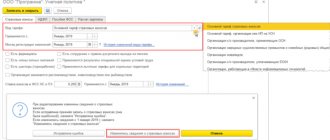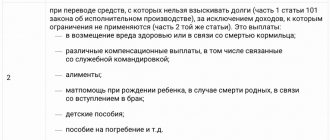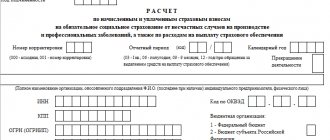Who submits the RSV
Insurance premiums are calculated by everyone who makes payments to individuals: organizations and separate divisions, individual entrepreneurs and individuals without individual entrepreneur status. Be sure to submit a calculation if you have insured persons:
- employees registered under employment contracts;
- employees registered under civil law contracts (contractor agreement, service agreement);
- director of the organization, even if an employment contract has not been concluded with him and he is the sole founder.
If the employer did not pay wages in the reporting quarter, he is still required to submit a report in zero format - the title page and empty sections 1, 1.1, 1.2 and 3. If the report is not submitted, the tax office will impose a fine of 1,000 rubles.
When is RSV adjustment needed?
You need to submit an updated calculation if you find the following errors in the already submitted calculation:
- any information about employees is not indicated or is incomplete;
- errors were made that led to an underestimation of the amount of insurance premiums payable.
An adjustment is necessary in case of understatement of contributions both for the organization as a whole and for individual individuals. It is also necessary to clarify the calculation if the individual cannot be identified. In other cases, correcting errors is a right, not an obligation, of the policyholder. For example, if an error led not to an underestimation, but to an overestimation of premiums, the policyholder may or may not submit an adjustment.
When and where to submit insurance premium payments
RSV - quarterly report to the tax office. Submit your payment no later than the 30th day of the month following the reporting period. The reporting periods for insurance premiums are quarterly, half-yearly, nine months and calendar year. The calculation we submit includes indicators from the beginning of the year to the end of the reporting quarter. That is, the DAM for the second quarter includes data for six months, and for the third quarter - data for 9 months of 2022. The deadlines for submitting the calculation are as follows:
- for the 4th quarter (2020) - February 1, 2022.
- for the 1st quarter - April 30, 2021;
- for the 2nd quarter (half of the year) - July 30, 2021;
- for the 3rd quarter (9 months) - November 1, 2021;
- for the 4th quarter (2021) - January 31, 2022.
If the delivery day falls on a weekend or holiday, the due date is postponed to the next closest working day. This can be seen in the 2022 report. The deadline of January 30th falls on a Saturday, so the date is postponed until Monday - February 1st.
The day on which you submitted the report to the tax inspector and received the acceptance stamp on the second copy is considered the day the calculation is submitted. When sent by mail, the day the post office accepted the package and stamped it. When sending by telecommunications - the day on which your TCS operator recorded the sending of the calculation.
Individual entrepreneurs and other individuals submit calculations to the tax office at their place of residence. Organizations and separate divisions that pay salaries to employees or performers report at their location.
Submit RSV and other reports in the Kontur.Accounting web service. The service itself will fill out the forms based on accounting data. Sending via the Internet.
Payment methods
Calculation of insurance premiums can be submitted on paper “by hand” at the tax office or by mail, but only if the average number of employees for the reporting period is no more than 10 people. Otherwise, the company faces a fine for violating the format.
If in the reporting period the average number of employees is more than 10 people, submit an electronic payment via the Internet using an enhanced qualified electronic signature.
Previously, all policyholders who had no more than 25 employees could submit a paper form.
Do I have to take zero marks?
The calculation must be submitted even if no activity was carried out during the reporting period. The absence of activity and payments to individuals, the absence of movements on accounts does not cancel the obligation to submit settlements. It’s just that in such a situation a zero calculation is submitted to the tax office.
It is filled in:
- Title page;
- Section 1 (no appendices). In line 001 the code “2” is indicated. In the lines “including for the last three months” zeros are entered. All other lines are filled in in the standard order;
- Section 3. Subsection 3.1 indicates the data of each individual. Field 010 remains empty. In the lines of subsection 3.2 of section 3, dashes are inserted.
New ratios for contributions within the DAM
| 1.193 | |
| if field 001 adj. 1 rub. 1 SV = 20, then the presence of adj. 1 rub. 1 SV with value 01 in field 001 is required | Missing adj. 1 rub. 1 SV with the value 01 in the 001 field if there is an adj. 1 rub. 1 SV with value 20 in field 001 |
| 1.194 | |
| if in subsection 3.2.1 p. 3 SV according to FL (according to SNILS + full name indicators) field value 130 = MS, then the presence of subsection 3.2.1 r. 3 SV for this FL with a value in the field of 130 = NR required | Subsection 3.2.1 p. is missing. 3 SV according to FL with a value in field 130 = NR in the presence of subsection 3.2.1 r. 3 SV for this FL with a value in the field of 130 = MS |
| 1.195 | |
| if in subsection 3.2.1 p. 3 SV according to FL (according to SNILS + full name indicators) field value 130 = VZHMS, then the presence of subsection 3.2.1 r. 3 SV for this FL with a value in the field of 130 = VZHNR required | Subsection 3.2.1 p. is missing. 3 SV according to FL with a value in field 130 = VZHNR in the presence of subsection 3.2.1 r. 3 SV for this FL with a value in the field of 130 = VZhMS |
| 1.196 | |
| if in subsection 3.2.1 p. 3 SV according to FL (according to SNILS + full name indicators) field value 130 = VPMS, then the presence of subsection 3.2.1 r. 3 SV for this FL with a value in the field of 130 = VPNR required | Subsection 3.2.1 p. is missing. 3 SV for FL with a value in field 130 = VPNR in the presence of subsection 3.2.1 r. 3 SV for this FL with a value in the field of 130 = VPMS |
| if in subsection 3.2.1 p. 3 SV according to FL (according to SNILS + full name indicators) field value 130 = MS, then in subsection 3.2.1 p. 3 SV for this FL with a value in field 130 = NR line 150 for each field value 120 = minimum wage | Line 150 for each value of field 120 of subsection 3.2.1 p. 3 SV with a value in field 130 = NR < minimum wage in the presence of subsection 3.2.1 r. 3 SV for this FL with a value in the field of 130 = MS |
| 1.198 | |
| if in subsection 3.2.1 p. 3 SV according to FL (according to SNILS + full name indicators) field value 130 = VZHMS, then in subsection 3.2.1 p. 3 SV for this FL with a value in field 130 = VZHNR line 150 for each field value 120 = minimum wage | Line 150 for each value of field 120 of subsection 3.2.1 p. 3 SV with a value in field 130 = VZHNR < minimum wage in the presence of subsection 3.2.1 r. 3 SV for this FL with a value in the field of 130 = VZhMS |
| 1.199 | |
| if in subsection 3.2.1 p. 3 SV according to FL (according to SNILS + full name indicators) field value 130 = VPMS, then in subsection 3.2.1 p. 3 SV for this FL with a value in field 130 = VPNR line 150 for each field value 120 = minimum wage | Line 150 for each value of field 120 of subsection 3.2.1 p. 3 SV with a value in field 130 = VPNR < minimum wage in the presence of subsection 3.2.1 r. 3 SV for this FL with a value in the field of 130 = VPMS |
How to check the correctness of filling out the DAM 2022 using control ratios, says READY SOLUTION in ConsultantPlus. If you obtain access to the K+ system, it is free for 2 days.
Fines for violations when submitting payments
For violation of the delivery format, when an organization with more than 10 employees submits calculations on paper, the tax office imposes a fine of 200 rubles.
If errors are made in the calculation (incorrect personal data or discrepancies in indicators), the tax office will send a notification of errors with a request to correct the calculation. The policyholder has 5 business days from the date the electronic notice is sent or 10 business days from the date the paper notice is sent to send an adjusted estimate. If these deadlines are violated, the calculation will be considered unsubmitted, which will result in a fine of 5% of the amount of contributions due.
For failure to submit a payment within 10 working days after the deadline for its submission, account transactions may be suspended.
If the payment is late, the tax office will fine the policyholder for each full or partial month of delay in the amount of 5% of the premiums payable. The total amount of the fine cannot be less than 1,000 rubles and more than 30% of the amount of contributions payable. For failure to submit a zero report, the fine will be 1,000 rubles.
Fines are distributed to the budgets of state non-budgetary funds in the same proportions as the insurance premium rates of 30%. For example, from 1,000 rubles, 733.33 rubles (22 / 30 × 1,000) will be sent to the Pension Fund budget.
How is a desk audit of insurance premiums carried out?
The procedure for conducting a desk audit is established by Art. 88 Tax Code of the Russian Federation. According to paragraph 1 of this article, control measures are carried out at the location of the tax authority. By virtue of the norms of paragraph 2 of Art. 88 of the Tax Code of the Russian Federation, insurance premiums are checked by authorized officials of the tax authority in accordance with their official duties without any special decision of the head of the tax authority within three months from the date the taxpayer submits a tax return (calculation) (see Letter of the Federal Tax Service of the Russian Federation dated September 21, 2016 No. BS-4-11/ [email protected] ). Taking into account the fact that the desk tax audit of insurance premiums is carried out on the basis of the calculation of insurance premiums, its beginning can be considered the date the tax authority receives the calculation. In this case, the date of receipt by the tax authority of the calculation and the date of the actual start of the desk tax audit of this calculation may not coincide (see Letter of the Ministry of Finance of the Russian Federation dated December 22, 2017 No. 03-02-07/1/85955).
During a desk audit of insurance premiums, the tax authority draws attention to the control ratios outlined in the Letter of the Federal Tax Service of the Russian Federation dated December 29, 2017 No. GD-4-11 / [email protected] We note that, guided by the specified letter, policyholders can check the completion of individual lines and sections .
Note that during a desk inspection, an act is drawn up within 10 working days from the date of completion of the inspection only if the Federal Tax Service has identified violations (clause 5 of Article 88 of the Tax Code of the Russian Federation). If the calculation has been checked and there are no errors, then, accordingly, the act is not generated.
New form of DAM from the report for 2022
The calculation form for insurance premiums in 2022 was updated by order of the Federal Tax Service of Russia dated October 15, 2020 N ED-7-11 / [email protected] The form has a KND number - 1151111. Detailed instructions for filling out the DAM are in Appendix No. 2 to the order. Filling out the form will require accuracy and attention, since errors in the calculation can lead to fines and the need to re-submit the DAM.
The main changes in the calculation affected the design of the form. It has become simpler and reduced by almost 1/3. Let's look at the innovations in more detail:
- Title page. A new field “Average headcount” has appeared; this data will need to be provided in the DAM for each reporting and billing period. A separate report on the average number of employees was deleted.
- Tariff codes and category codes of insured persons . Tariff codes that were introduced in the first half of 2022 were added to the order. For SMEs that pay contributions from payments above the minimum wage at reduced rates, the payer tariff code “20” and the insured person category codes “MS”, “VZhMS”, “VPMS” have been approved. For policyholders who have a zero premium rate, the payer tariff code “21” and the insured person category codes “KV”, “VZhKV”, “VPKV” were approved.
- Appendix 5.1 . It is relevant for payers from the IT sector, who, as part of the tax maneuver, have received reduced insurance premium rates from January 1, 2022. The application is completed to confirm your compliance with the conditions for applying the reduced tariff. This applies to electronics, software and database developers.
- New payer rate codes and category codes of insured persons for the IT sector . Developers of electronics, programs and databases who meet the conditions for applying reduced tariffs will enter the tariff code “22”. The codes for the categories of insured persons are as follows: “EKB” - individuals; “VZhEK” - persons from among foreign citizens or stateless persons temporarily residing in the Russian Federation, as well as temporarily staying refugees; "VPEC" - foreigners or stateless persons temporarily staying in the Russian Federation.
Submit RSV and other reports in the Kontur.Accounting web service. The service itself will fill out the forms based on accounting data. Sending via the Internet.
What to check in Appendices 1 and 2 to Section 1
Please check Appendices 1 and 2 in the DAM for the year separately, after a control check of the database and insurance premiums according to special reports in 1C.
Check the calculation of the taxable base by type of accrual. Check whether your program has the correct division into taxable and non-taxable parts. It is possible that in the fourth quarter there were new types of payments to employees, and for them the base for contributions was formed incorrectly. This needs to be checked in the program.
The maximum value of the base for insurance premiums for 2021
| Type of compulsory insurance | Limit value |
| Pension | RUB 1,465,000 |
| Social | RUB 966,000 |
| Medical | — |
When checking the annual DAM, check the general base for calculating contributions and only after that – the DAM, which generates “1C: Salaries and Personnel Management 8” ed. 3. Check the database using the report Taxes and contributions – Reports on taxes and contributions (Section Insurance premiums) – Analysis of contributions to funds
(Fig. 1). The value for calculating contributions must be equal to the total amount of payments minus non-taxable amounts, taking into account the maximum values for calculating contributions for compulsory pension and social insurance.
Rice. 1. Analysis of contributions to funds
Report Analysis of Fund Contributions
can be configured in “1C: Salaries and HR Management 8” edition 3 specifically for your company and save several report options for specific legal entities in the program.
Report Analysis of Fund Contributions
additionally configure:
- by type of accrual;
- employee breakdown;
- in terms of employee status (selection for temporary residents, temporarily staying employees);
- by neighborhood.
To make additional settings in the Fund Contribution Analysis
Contact your company's service partner.
In “1C: Salaries and Personnel Management 8” edition 3 there is another additional calculation for monitoring contributions - Checking the calculation of contributions
, but it is formed with a breakdown for each employee and month.
Checking the calculation of contributions
is located in the same section with
the Analysis of contributions to funds: Taxes and contributions – Reports on taxes and contributions (Section Insurance contributions) – Checking the calculation of contributions
(Fig. 2).
Rice. 2. Checking the calculation of contributions
Appendix 1 to Section 1
In the first appendix, two subsections are required to be completed: subsection 1.1 reflects the amount of contributions for compulsory pension insurance, subsection 1.2 contains information about payments for compulsory health insurance.
Both subsections contain the same fields to fill out, but if in subsection 1.1 the contribution amounts are divided into deductions before and after exceeding the limit on contributions to compulsory health insurance, then in subsection 1.2 there is no such division, since there are no limits on contributions to compulsory medical insurance.
Next, check the completion of the payer tariff code. The full list is given in Appendix 5 to the order of the Federal Tax Service No. ММВ-7-11/470. A frequently used code is 01, when the policyholder pays premiums at the basic insurance premium rates.
Check the taxable base: in subsection 1.1 of Appendix 1 to Section 1 the control ratio must be met:
Columns 1 (2,3,4) lines 050 = Columns 1 (2,3,4) lines 030 - Columns 1 (2,3,4) lines 040
All calculated contributions must be equal to the amount of contributions from payments within and above the limit. For reconciliation, use the ratio of indicators in subsection 1.1 of Appendix 1 to Section 1 (see below):
Columns 1 (2,3,4) lines 060 = Columns 1 (2,3,4) lines 061 + Columns 1 (2,3,4) lines 062
Also control the amounts payable by fund in section 1. Pension contributions payable must be equal to the total amount of contributions calculated for all tariffs. Apply the ratio:
Lines 030 (031,032,033) of section 1 = Amount of column 1 (2,3,4) of line 060 of subsection 1.1 of Appendix 1 for all tariffs
If equality is not met, check the indicators. There may be an error in the total amount of insurance premiums payable (lines 030–033 of section 1), or the amounts for individual tariffs have been calculated incorrectly.
The amount of contributions for health insurance must be equal to the amount of calculated contributions for all tariffs, that is:
Lines 050 (051,052,053) of section 1 = Amount of column 1 (2,3,4) of line 060 of subsection 1.2 of Appendix 1 for all tariffs
If equality is not met, check whether there may be errors in the total amount of insurance premiums payable (lines 050–053 of section 1) or in the indicators for individual tariffs.
How to fill out the RSV
Fill out the fields in the calculation from left to right, starting with the first acquaintance. Indicate monetary amounts in rubles and kopecks. If you fill out the calculation manually, use blue, black or purple ink. If you fill out the calculation on a computer, use capital block letters, Courier New font size 16-18; if there are no indicators, there is no need to put dashes and zeros. If there are no indicators, put zeros (for amounts) or dashes (for text) in the cells. When filling out, you don’t have to put anything on your computer.
Those dismissed in the DAM report are indicated in section 3 of the calculation: it lists all persons in whose favor payments were made in the reporting period and employees dismissed in the previous reporting period. The attribute of the insured person for dismissed employees “1” must also be indicated.
After filling out the calculation, number the pages consecutively, regardless of the absence of sections to be filled in or their number. At the end of the article we provide a sample of a completed calculation for an organization with two employees.
What is included in the updated DAM calculation
The DAM adjustment is submitted in the form approved by order of the Federal Tax Service dated September 18, 2022 No. ММВ-7-11/ [email protected]
The updated report form differs from the primary one by the adjustment number in a special field. In the initial calculation, zero is indicated as the adjustment number on the title page, and in the updated calculation - 1, 2, 3, and so on, depending on the time the form is submitted.
The updated calculation includes previously submitted sections and appendices to them, taking into account the changes made. The exception is section 3 “Personalized information about insured persons” - it must be included only for individuals for whom changes have occurred.
In the clarifying calculation, only new correct indicators are indicated. There is no need to indicate the amounts by which the primary report data decreased or increased.







